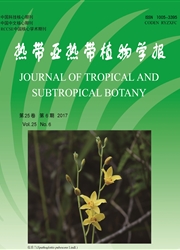

 中文摘要:
中文摘要:
研究分析了广西猫儿山中山森林中3种落叶阔叶树(亮叶水青冈Fagus lucida;青榨槭Acer davidti;缺萼枫香Lktuidambar acalycina)和4种常绿阔叶树(铁椎栲Castanopsis lainontii;曼青冈Cyclobalanopsis oxyodon;桂南木莲Manglietia chingii;银木荷Schima argentea)光合特性的季节性变化。除青榨槭外,在雨季饱和光照下,落叶树与常绿树的最大净光合速率(P-)差异不明显,而落叶树的最大气孔导度(G-)要比常绿树高;在旱季,落叶树的P-和Gmax下降幅度远大于常绿树,这伴随前者暗呼吸速率和光补偿点的大幅提高。常绿树和落叶树的表观量子效率(AQY)和凌晨光系统II潜在最大光化学效率(Fv/Fm-predawn)在雨季差异不明显;在旱季,落叶树的AQY和Fv/Fm-predawn小于常绿树,说明前者遭受较严重的光抑制。此外,光合速率与气孔导度呈显著直线相关,但常绿树的直线斜率要比落叶树大,说明前者光合水分利用效率较高,这有利于常绿植物在干旱和低温条件下生存。光合速率与电子传递速率和温度也呈显著直线相关,但常绿树的直线斜率都小于落叶树,这说明常绿植物可以调节电子传递速率的变化来适应温度的宽幅的季节性变化。总之,落叶阔叶树需要相对较高的温度和水分供应才能满足光合作用的需要,而在干旱和低温条件下,落叶阔叶树尽管可以通过气孔和光系统II的调节来适应环境的变化,但还是无法避免严重的光抑制从而导致叶片脱落;与之相反,常绿植物却可以通过气孔调节提高水分利用效率和通过电子分配耗散多余能量来适应干旱和低温的胁迫而使叶片维持四季常绿。
 英文摘要:
英文摘要:
The Seasonal changes in photosynthetic characteristics of three deciduous broad-leaved species (Fagus tucida, Acer davidii, and Liquidambar acalycina) and four evergreen broad-leaved species (Castanopsis lamontii, Cyclobdanopsis oxyodon, Manglietia chingii, and Schkna argentea) in Guangxi Mao'er Mountain were studied. Except of Acer davidii, there was not significant difference in maximum photosynthetic rate at saturating light (Pmax) between the deciduous and evergreen species, but maximum stomatal conductance at saturating light (Gmax) was higher in the deciduous species than the evergreen species in rainy season. However, in dry season, the decreases of Pmax and Gmax were greater in the deciduous species than the evergreen species, as accompanied by the larger increases in dark respiration rate and light compensation point in the former. The deciduous and evergreen species had slight difference in apparent quantum yield (AQY) and predawn maximum photochemical efficiency of photosystem II (Fv/Fm-prdeawn) in rainy season. However, in dry season, the deciduous species showed lower AQY and Fv/Fm-predawn. than the evergreen species, suggesting that the deciduous species suffered greater photoinhxbition. Furthermore, there was a significant linear relationship between P and G, and the evergreen species showed lower slope, indicating that the evergreen species had higher photosynthetic water use efficiency and this would help them to survive in dry and cold conditions. Also, the significant linear correlations of P with electron transport rate and leaf temperature were observed in both the deciduous and evergreen species, and the evergreen species exhxbited lower slope; this indicates that the evergreen species could adjust the electron transport rate through alternative electron pathways conclusion, the results obtained here suggest that the to adapt to the wide range of seasonal temperatures. In deciduous species required relatively higher temperature and water supply than the evergreen sp
 同期刊论文项目
同期刊论文项目
 同项目期刊论文
同项目期刊论文
 期刊信息
期刊信息
